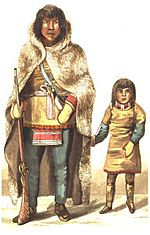Akaitcho facts for kids
Quick facts for kids
Chief Akaitcho
|
|
|---|---|

Portrait of Chief Akaitcho and his only son, by Robert Hood.
|
|
| Born | ca. 1786 |
| Died | Spring 1838 |
| Resting place | An island in Great Slave Lake's Yellowknife Bay |
| Other names | "Big-Foot", or "Big-Feet" |
| Known for | Chief of the Yellowknives |
| Relatives | François Beaulieu, brother-in-law |
Akaitcho (pronounced Ah-KAI-cho), also known as "Big-Foot," was an important leader of the Yellowknives First Nation in Canada. He lived from about 1786 to 1838. His name means "like a wolf with big paws," suggesting he could travel long distances over snow.
His people lived in a large area. This stretched from the eastern part of the Great Slave Lake in the Northwest Territories to the Coppermine River in Nunavut. Akaitcho was famous for his strong leadership. He also helped explorers like John Franklin on their journeys. He played a key role in one of the first expeditions to find the Northwest Passage.
Contents
Akaitcho's Leadership and Influence
Akaitcho was seen as a very smart and strong leader. His tribe, the Yellowknives, spoke their own special language. They were part of the larger Chipewyan people.
The Yellowknives traded meat with the North West Company. This company had a trading post called Fort Providence. It was located on the East Arm of the Great Slave Lake. Akaitcho's tribe was also known for their strength and courage. They sometimes had conflicts with other groups like the Dogrib and Hare Indians.
Helping the Coppermine Expedition
In 1820, Akaitcho and his men were asked to help a Royal Navy expedition. This group was searching for the Northwest Passage. Akaitcho's tribe had about 190 members at this time. His brothers, Humpy and White Capot, also joined the expedition.
The explorers met Akaitcho at Fort Providence in July. The expedition team included John Franklin, a doctor named John Richardson, and two young officers, Robert Hood and George Back.
Akaitcho agreed to help under certain conditions. He wanted his tribe's debts to the North West Company to be cancelled. He also asked for supplies like cloth, ammunition, tobacco, and iron tools. In return, his men would hunt and guide the expedition. They would travel north along the Coppermine River. They also promised to leave food for Franklin's group when they returned. Akaitcho warned Franklin that food might not always be easy to find.
They reached their winter camp, Fort Enterprise, with low food supplies. Franklin's men were starting to lose hope. They had to wait several months for better weather to continue their journey.
Challenges on the Journey
The Franklin expedition started again in June 1821. They reached the Arctic Ocean by July 14. Franklin then told the Yellowknives to leave food along the way back to Fort Enterprise. He also asked them to restock Fort Enterprise.
However, the Yellowknives did not fully restock the fort. Three of Akaitcho's hunters died after falling through ice. Also, Akaitcho did not receive the ammunition he needed to hunt. The main reason was Akaitcho's belief that the expedition was too risky. He thought Franklin's group would not survive the return trip.
Weeks later, George Back returned to Fort Enterprise before Franklin. He found no food there. Back then went to Fort Providence. He convinced some of Akaitcho's men to return with him. On November 7, Back and three Yellowknives found Franklin's starving group at Fort Enterprise. The Yellowknives brought meat and fish. They also cared for the survivors. A week later, the group left Fort Enterprise. They safely reached Fort Providence on December 11.
In their journals, Franklin called the chief "Akaitcho" or "Big Foot." Richardson called him "Akaicho" or "Gros Pied." Back referred to him as "Ekeicho."
Later Years and Peacemaking
When the Fort Providence trading post closed in 1823, Akaitcho had to trade at Fort Resolution. This meant competing with other Chipewyan people already trading there. His power and influence began to lessen.
In 1825, Akaitcho became a peacemaker. He took part in an important peace treaty at Mesa Lake. This treaty ended a long period of fighting between the Chipewyan and Dogrib tribes. He worked with Dogrib Chief Edzo to bring peace.
In 1833-1834, George Back returned to the area. He set up a base camp at Fort Reliance while looking for another lost expedition. Akaitcho's strong spirit and determination earned Back's respect once more.
By the time he was 50, Akaitcho's health was not good. His power over his tribe also started to decrease.
Akaitcho's Family Life
Akaitcho had several brothers, including Humpy, White Capot, and Keskarrah. Keskarrah was known to travel with Matonabbee, another Chipewyan chief. Akaitcho also had a sister who married François Beaulieu, a Métis chief.
Akaitcho had seven wives. His favorite wife gave birth to his only son. As he grew older, younger men would carry Akaitcho and his elder wives when the tribe moved. This showed great respect for them.
Akaitcho's Legacy
Akaitcho's memory is honored in several ways. The Akaitcho Territory Government is a First Nations organization. It represents the Dene people of the Northwest Territories. This group was formed in his honor.
Akaitcho Lake is also named after him. This lake is located in Nunavut, between Great Bear Lake and the Coppermine River.

